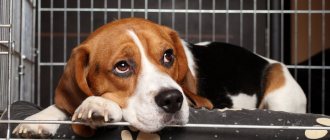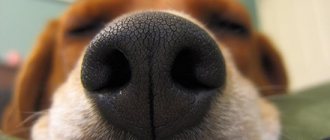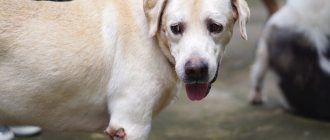Why does a dog cough?
The causes of cough in dogs can be very diverse. Conventionally, they can be divided into two groups: those associated with diseases of internal organs and household ones. Among the first are often found:
- bacterial, viral, fungal infections of the nasopharynx, respiratory tract, lungs;
- heart diseases;
- allergies;
- neoplasms;
- helminthiases.
Factors of the second group that provoke a cough reflex in an animal include the following.
Check to see if the collar is too tight on your dog's throat - this may be the cause of the cough.
- Tight collar. The dog coughs when it is over-tightened (“so as not to run away”), if the collar has become small, while the leash is being pulled. The latter is especially typical for young, overly active pets. Coughing is often associated with a leash in dogs with too short or, conversely, long necks. In the first case, it is preferable to use a harness, and in the second, carefully select the width of the accessory.
- Accumulation of hair in the esophagus and stomach. The problem is typical for four-legged animals with long hair. When licking (although not frequently), the dog involuntarily swallows hair, which does not move along the digestive tract, but gradually collects in a lump in the stomach or esophagus. Such accumulations lead to a gag and cough reflex. At the same time, the dog coughs as if he was choking.
- A foreign object is stuck in the throat. Anything can get stuck: a thread, New Year's rain, a fish bone, a chicken bone. The thread, if it is not completely swallowed, will irritate the mucous membrane of the oropharynx and esophagus for a long time, causing coughing and vomiting. Sharp bones, piercing the tissues of the oral cavity, pharynx, and esophageal wall, not only create a feeling of interference in the animal, but also lead to inflammatory processes (suppuration, pain, swelling of the mucous membrane, etc.).
- Features of the anatomical structure of the pet's respiratory tract, oropharynx and esophagus. Short-faced animals are characterized by the so-called reverse sneezing. This is a paroxysmal cough, not associated with diseases, that occurs suddenly and passes quickly, without outside help.
Main causes of difficulty breathing
Entry of a foreign body into the respiratory tract
Dogs are naturally curious creatures, so they tend to put various objects in their mouths that can play a cruel joke on them. Stuck in the throat, various little things can lead to suffocation, as a result of which the dog begins to choke and wheeze. This often happens during play, when a pet is chasing a ball, stick or other toys.
But another common reason for a dog choking and coughing can be food if it was swallowed greedily or simply went “down the other throat.” A dog can choke on too large a piece of meat, as well as on a fish or meat bone that is stuck in the throat, or even on dry food.
Some dog breeds are distinguished by their special speed in eating food, regardless of the degree of their hunger - they always eat this way, trying to get enough as soon as possible. A very hungry animal or pet, which the owner leaves for a long time without food, greedily pounces on food as soon as it is given to him. And it is not surprising that it ends up in the windpipe or gets stuck.
A four-legged pet can even die from a bone stuck in the throat; in addition to a fish bone, this situation can also be caused by a piece of large meat muscle, large, albeit soft, cartilage, as well as tubular bones.
Both an adult and a puppy can choke on dry food. Particles of such food, being moistened with saliva, are compressed into too large a piece and simply get stuck in the throat. When coughing, the dog makes sounds as if it was choking, but cannot spit out the stuck lump. It is better to choose dry food in the form of large granules. The pet will be forced to chew them before swallowing them.
We advise you to read: Fighting Dog Breeds
Owners who keep several representatives of the dog family, as well as owners of shelters and kennels, know well what competition between animals is. Among the dogs there are many who try to quickly eat their own portion in order to have time to enjoy the contents of their neighbor’s bowl. This concept of behavior often represents a principle of survival, which manifests itself even when the dog is in favorable conditions and receives sufficient food. But with these smaller “eternally hungry” brothers, situations where they choke on food in a hurry happen quite often.
The cause of a cough can also be a cold or an inflammatory disease, as a result of which the dog does not choke on anything, but his throat is sore and severe dryness is felt, causing a cough, with the help of which the dog tries to relieve the irritation. In such cases, it is necessary to treat the underlying disease, and after recovery the cough will disappear.
Breed predisposition
Pets of dwarf breeds, as well as brachycephals, are characterized by a special structure of the pharynx and respiratory apparatus. This anomaly is considered congenital - due to the soft palate, a sharp sip or inhalation leads to contraction of the larynx. At this moment, the palatal tissues block the airways for a short moment, and the dog gasps and wheezes as if he was choking. Fortunately, the problem resolves itself after a few seconds.
Brachycephalic syndrome in four-legged animals is expressed in noisy breathing, up to wheezing or snoring in a calm state.
At night, the dog may snore quite loudly, he is forced to take special positions during sleep, and he may often experience shortness of breath and other symptoms.
Chest trauma
Most of the injuries that a four-legged friend receives in various negative situations - be it a bite from a larger individual, an accident involving a fall from a height or being hit by a car - are characterized by damage to the chest and the organs located in it. Such injuries can be accompanied by an accumulation of air in the animal’s chest, which also leads to breathing problems - the dog cannot breathe and in such a situation cannot be avoided without medical intervention. Sometimes it is enough to remove the air through a small puncture; in more complex cases, surgery is required.
Tracheal collapse
Breathing problems are not uncommon in small breeds such as Chihuahuas. Various developmental defects, congenital or acquired, lead to the fact that the soft tissues of the trachea become inflamed and softened. And then the dog coughs, as if choking, she experiences shortness of breath, and while eating, vomiting may occur. As a result, the dog may begin to refuse food and water.
The danger of tracheal collapse is that without timely help, the dog may even die from suffocation. In unadvanced cases of the disease, medications in the form of special nutritional supplements help, with the help of which the tracheal tissues are restored. If the situation is more complex, then surgery is performed.
We advise you to read: Is it possible to wash a dog with soap?
Types of cough in dogs
Cough in dogs is classified based on several characteristics. It is important that the owner, when contacting a veterinary clinic, can talk about each of them in sufficient detail.
Parameter
Type of cough
Presence/absence of sputum
- Wet (with mucus)
- Dry (without it)
Character of the course
- Acute (appears sharply, pronounced)
- Subacute (develops progressively, gradually intensifying)
- Chronic (lasts a long time)
Severity of manifestation
- Minor
- Strong
- Paroxysmal
Cough frequency
- Rare
- Frequent
In addition, there is a seasonal cough - an allergic reaction of the pet’s body to changes in nature.
Associated symptoms
Coughing in dogs can occur on its own or be accompanied by other symptoms. Among them:
- vomit;
- blood in sputum;
- foamy discharge from the mouth;
- temperature increase;
- refusal of food;
- muscle weakness (the animal has difficulty moving);
- breathing problems, shortness of breath, and so on.
Some diseases develop rapidly and can lead to the death of your pet. If your dog's condition suddenly worsens, you should immediately contact a veterinarian.
Diagnosis of cough in a dog
A dog's cough can cause serious illness, so it is recommended that you take your pet to see a veterinarian.
At the veterinarian's appointment, the pet will be examined and the owner will be questioned. It will be necessary to talk about the characteristics of the cough, its duration, and the conditions accompanying its occurrence. You will need to provide information about the dog’s age, the presence of any diseases, vaccinations, living conditions, etc. The complex of diagnostic procedures may include methods such as:
- X-ray;
- bronchoscopy;
- ECG;
- cytological, bacteriological examination of sputum.
Cough when a foreign body enters the respiratory tract
As a rule, if a dog chokes or swallows something extra, it copes with the situation on its own by coughing up. At such a moment, the cough begins suddenly, sharply, accompanied by corresponding movements of the neck and head, and a characteristic posture.
There may be another situation: the animal choked on a sharp bone, an object that, due to its shape or size, got caught in the mucous membrane. Then the following symptoms may appear:
- cough in fits and starts, prolonged, debilitating;
- during the cough reflex, the pet tries to push the foreign body out of the throat;
- wheezing;
- difficulty breathing;
- foam from nostrils;
- cough with blood, foam;
- refusal to drink and eat.
You cannot hope that the dog will cope on its own. Trying to pull out (or even see) what got into her throat is almost impossible without special tools. The animal needs to be taken to the clinic urgently. Delay threatens the development of emphysema, inflammatory processes in the bronchi, lungs, pleura and other complications.
When does a dog cough as if he is choking?
To determine what causes the cough, it is also useful to observe what kind of cough it has.
“She’s coughing, as if she’s choking,” owners often say. In such a situation, the explanation can be very simple: the dog is trying to get rid of what bothers it. Let's say some foreign object ends up in the bronchi. A sliver of a stick, a piece of a toy, some ears of corn, even a small object accidentally eaten on the street. Sometimes such a cough looks like an attack, the dog is observed coughing white foam, and sometimes the dog coughs with blood. It is possible that the dog has ingested poison and veterinary attention is required immediately.
If the dog drank cold water or drank ice cream (in the heat, sometimes owners pamper their pets in such a strange way), the tonsils could become inflamed. Your pet may want to “cough up” them as if they were foreign to their body.
Sometimes dogs try to cough up worms. Prevention of helminths helps to cope with them, but if the owners did not do it, a lot of worms can accumulate in the esophagus. And there is nothing strange in the fact that the dog wants to get rid of them by coughing.
Aviary (kennel) cough in a dog
Aviary cough is a symptom of some infectious (mainly viral) diseases of dogs, so named because of the most common cause of infection - living together or frequent contact of animals with each other. The source of infection is a sick or recovering dog.
Signs of the disease are determined by the characteristics of the pathogen (parainfluenza, canine herpes, bordetella), as well as the state of the animal’s immune system. After the incubation period (up to 10 days) has passed, the following manifestations of pathology are possible:
- a slight paroxysmal cough, similar to the dog choking, but less pronounced;
- cough with white foam;
- swollen lymph nodes;
- increase in temperature indicators;
- lacrimation;
- discharge from the nostrils.
Kennel cough lasts approximately 2 weeks. The stronger the dog’s immunity, the easier it tolerates the infection, sometimes without even requiring special treatment. In severe cases, the use of antibacterial, antiviral, expectorant, immunomodulatory and other agents is indicated (based on examination results).
Treatment of cough in dogs and puppies
Kennel cough is a symptom of some pathology, which can only be diagnosed by an experienced veterinarian. You should not draw conclusions about your pet’s health status on your own.
Read Nausea and vomiting in dogs: causes, signs and treatment
To make a diagnosis, the veterinarian prescribes a set of necessary tests and collects the animal’s history, including finding out its age, gender, breed, asking about previous diseases, the nature of the cough and its accompanying symptoms.
The treatment regimen is selected for each dog individually, since therapy methods that are suitable for one animal may not help or even harm another.
Aviary
To successfully treat kennel cough in dogs, it is necessary to use expectorants and emollients; in severe cases, it is impossible to do without the use of broad-spectrum antibiotics. However, due to the negative impact on the dog’s body, they are prescribed only during an exacerbation that threatens to develop into pneumonia.
Important! You cannot treat your pet with medications intended for humans - they contain too high a concentration of the active substance.
The owner can also alleviate the pet’s condition and contribute to its speedy recovery. To do this, it is necessary to provide the dog with adequate care by placing it in a warm room with a sufficiently high level of humidity, eliminating the possibility of the mucous membranes drying out after sleep.
Pneumonia
For bacterial pneumonia, the animal is prescribed broad-spectrum antibiotics, expectorants in the form of tablets or syrups (for example, Lazolvan) and a course of multivitamins.
If the disease occurs due to fungi, it is necessary to first identify the pathogen and only then prescribe a drug whose action is aimed at combating this particular strain of fungi. Today, fungal pneumonia is best treated by inhalation.
The dog also needs to be provided with rest, kept in a warm place and a light diet.
Cordial
Cardiac hypertrophy and accumulation of exudate in the lungs, which lead to cardiac cough, can only be detected using ultrasound or x-ray diagnostics.
Treatment should be aimed at the root cause of the pathology, therefore, the use of cardiac and diuretic drugs is prescribed to reduce swelling and vitamins to maintain the animal’s immunity. In some cases, it is necessary to take antibacterial agents.
You also need to minimize your pet’s physical activity, reduce the amount of liquid it consumes, and use emollients and expectorants to facilitate coughing.
Only a cardiologist can prescribe treatment based on the medical history and tests performed. The result of therapy depends on the age of the dog and the stage of development of the disease.
Parasitic
First of all, you need to find out what kind of parasites your pet is infected with. To do this, the veterinarian takes tests from the dog, and then, based on the results obtained, prescribes a drug whose action is aimed at removing helminths from the animal’s body. After helminthiasis is cured, the incomprehensible cough stops.
Treatment of parasitic infestation is possible only in a veterinary clinic, since it involves the use of specific drugs, most often containing arsenic. Despite the insignificant amount of toxic substance in the composition of the medicine, it should not be used at home.
Oncological
In most cases, cancerous tumors in dogs are not treatable, and all that a veterinarian can do is to alleviate the animal’s condition using medications.
For these purposes, vitamins A, C, E and group B are prescribed, as well as steroids, bronchodilators and bronchodilators - they help relieve inflammation and make the dog’s breathing easier.
Expectorants and Echinacea help remove mucus and blood clots that accumulate inside the bronchi and make breathing difficult.
Allergic
Allergies are one of those diseases that cannot be completely cured. Therapy consists only of stopping the symptoms that appear.
First of all, it is necessary to identify the allergen and eliminate or at least minimize the animal’s contact with it. Then antihistamines, vitamins and agents aimed at maintaining the immune system are prescribed.
Read Causes of abscess in dogs, signs and methods of treatment
Entry of foreign objects
If your dog can't clear his throat after eating, he's probably choking on a bone or something else. In any case, a foreign object stuck in the esophagus or adhering to the mucous membrane must be removed. You should not do this yourself, without the help of a veterinarian - this can only harm your pet.
In such a situation, the doctor performs an endoscopy, that is, removes the irritant from the respiratory tract using tweezers and a special backlit mirror.
If the animal behaves aggressively and does not allow the specialist to approach it, the procedure is performed under general anesthesia. If a dog has trouble breathing and loses consciousness, the veterinarian will perform a tracheotomy to allow air into the lungs before removing the foreign object.
Important! You should not give your animal a laxative - this will only make the situation worse.
Tracheal collapse
At an early stage of the disease, the dog is prescribed drugs and nutritional supplements that promote the restoration of tracheal tissue. If treatment does not give a positive result or the disease was discovered too late, an operation is necessary to replace the damaged tracheal rings with artificial implants.
Features of cough in dogs with certain diseases
The cough reflex only indicates the presence of a pathological process in the body, and is not an independent disease. What type of cough occurs in dogs depends on the underlying disease. Knowing the characteristics of cough syndrome and accompanying symptoms will speed up the diagnosis and allow you to provide your pet with timely treatment and first aid.
Allergic reaction
Allergies in dogs manifest themselves in a variety of symptoms. The cough may be accompanied by:
A dog's cough may be caused by an allergic reaction.
- discharge from the nostrils, eyes;
- swelling of the mucous membranes;
- redness of the eyes;
- sneezing;
- skin rashes;
- itching and other symptoms.
The owner should monitor the pet; perhaps cough and other signs appear after eating certain foods, after a walk, and are seasonal. If an allergen is identified, it is excluded from the dog’s life and appropriate therapy is carried out.
Bronchitis
The inflammatory process in the bronchi - bronchitis - is initially accompanied by a dry, severe cough from your pet. It is most pronounced in the morning: wheezing and whistling are heard. After a few days, the cough becomes wet and whitish or yellowish sputum appears. Additional symptoms of the disease include shortness of breath, difficulty breathing, and increased body temperature.
The owner should know that bronchitis can be both viral and bacterial, so treatment in both cases will be different. You can determine the pathogen “by eye” by the severity of the symptoms: with the bacterial form they are stronger, and the dog’s condition is much worse. In addition, if bronchitis is caused by bacteria, the pet’s body temperature will be 2 degrees or more above normal (with a viral infection it rises within one degree).
Helminthiasis
The life cycle of some parasites is associated with the migration of swallowed larvae from the stomach and intestines to the lung tissue. The helminths spend about 2 weeks in the respiratory organs, and then they are expectorated, swallowed along with sputum, and grow into adults in the intestines.
While in the dog's lungs, worms lead to the following symptoms:
- wet cough mixed with blood;
- difficulty breathing, shortness of breath;
- temperature rise, sometimes quite strong, up to 43 °C.
It is possible to say with greater certainty that the cough has a parasitic cause if, shortly before these manifestations, the animal had problems with digestion, pain in the intestines, or diarrhea.
Pulmonary infarction
Dogs with cardiovascular pathologies are at risk of developing pulmonary infarction. This may occur due to a blood clot breaking off. A characteristic sign is severe, sharp pain, during which the animal jumps and may scream. Almost immediately, shortness of breath and coughing with blood mucus begins. The dog weakens before our eyes, the mucous membranes turn pale, the heartbeat is disrupted, blood pressure drops, and the temperature rises. The pet should be taken to the clinic immediately.
Laryngitis
Inflammation of the dog's pharynx is also accompanied by a cough. At the early stage of the disease, it causes suffering to the animal: a dry and persistent cough causes pain, so the pet may refuse to eat, stop barking (or make hoarse, hoarse sounds). Gradually, the cough reflex becomes productive, a small amount of sputum is released, and as the inflammatory process in the mucous subsides, pain disappears. Body temperature remains within normal limits or rises slightly.
Adenovirus
This disease is of viral origin. The mucous membrane of the upper respiratory tract and throat is affected. Symptoms of adenovirus:
- sore throat (the animal reacts accordingly when palpation is attempted);
- enlarged lymph nodes under the jaw;
- productive cough;
- cough discharge may be clear or cloudy;
- lacrimation;
- discharge from the nostrils;
- slight increase in temperature indicators;
- refusal of food;
- in the intestinal form, vomiting, nausea, indigestion, diarrhea and pain in the intestinal area are observed.
Heart diseases
If your dog has heart defects or disease, he may develop a heart cough. It is characterized by pink color of sputum, due to the leakage of blood into the lungs through the capillary walls. Foamy pink discharge from the respiratory system is accompanied by other symptoms of heart failure:
- increased cough after physical activity;
- weakness of the animal;
- labored breathing;
- mucous membranes acquire a bluish tint.
Heart cough in four-legged friends, unfortunately, has a poor prognosis. At best, the dog can live 2-4 years. The pathology can only be treated surgically, but due to the complexity and high cost of operations, they are not performed.
Bronchial asthma
The development of bronchial asthma in a dog can be triggered by prolonged exposure to various allergens, volatile chemical compounds, nervous stress, weather conditions, and infectious diseases. The dog coughs as if it was choking, accompanying the attacks with corresponding movements of the head and body. Characteristic signs of the disease are:
- the appearance of attacks after physical stress, their absence during rest;
- discharge of thick transparent mucus from the bronchi;
- bluish mucous membranes;
- suffocation during an attack;
- redness of the eyes;
- sneezing.
The main types and causes of cough in dogs
In brachycephalic dogs (Spitz, pugs, bulldogs), wheezing, coughing and the so-called reverse sneezing or reverse cough are due to the specific structure of the skull. In other breeds, they can be triggered by stress caused by a sudden change of environment or fear.
If your pet coughs after prolonged barking, there is no need to worry. However, a dog’s cough is often a sign of serious illnesses, including:
- inflammation of the respiratory system;
- tracheobronchitis;
- oral infections;
- heart diseases;
- tumors;
- parasitic infection;
- allergy;
- tracheal collapse.
In addition, a severe cough may be caused by irritation caused by contact with smoke or fumes, or the presence of a foreign object in the respiratory tract.
You should pay attention to the nature and duration of the cough, as well as the presence of other symptoms, such as:
- weakness;
- sleep disturbance;
- temperature increase;
- loss of appetite;
- aggressive behavior;
- nausea and vomiting;
- weight loss;
- formation of ulcers in the mouth, bleeding gums;
- enlarged lymph nodes.
Important! If your dog develops a cough that continues on the second day, or if additional symptoms are observed, you should contact your veterinarian.
Nursery
Kennel or kennel cough is the name given to viral laryngotracheitis or tracheobronchitis, an infection of the pulmonary system transmitted by airborne droplets from one dog to another.
Characteristic symptoms:
- dry, hacking cough;
- lethargy;
- sneezing;
- vomiting and nausea;
- snorting sounds;
- loss of appetite;
- swelling of the throat;
- enlarged tonsils.
As a rule, the first symptoms appear 2-14 days after infection.
The disease can develop in both a puppy and an older dog that is in close contact with other animals, for example, in a shared enclosure, kennel, pet store or at an exhibition.
Important! Lack of timely treatment can trigger the development of pneumonia.
Pneumonia
Pneumonia can occur both as a result of a complication of viral tracheobronchitis, and due to fungi, liquids or food debris that have entered the respiratory system.
With this pathology, the dog has a deep, barking, hoarse, wet cough, sometimes with phlegm. In addition, a pet with pneumonia becomes lethargic, loses weight sharply, loses appetite, body temperature rises, and wheezing is heard in the lungs.
Cordial
The main cause of cardiac cough is damage to the mitral valve. The pathology provokes an increase in the size of the heart and the accumulation of fluid in the lungs, which puts strong pressure on the trachea.
This symptom also occurs with dilated cardiomyopathy. This pathology is typical for dogs of large breeds (Dobermans, Labradors, Shepherds); it is extremely rare in puppies and adult animals weighing up to 7 kg.
Signs of the disease:
- accumulation of fluid in the abdominal cavity;
- coughing;
- dyspnea;
- weakness;
- loss of appetite;
- gums have a bluish-gray tint;
- decreased activity;
- The dog wheezes and develops a dull cough, especially when barking or exercising.
The pet coughs at night and in the morning, and has difficulty withstanding hot and humid weather. From the outside it seems as if he is trying to regurgitate something or cannot clear his throat.
Read Causes of hematobartonellosis in dogs: signs and methods of treatment
Reference! Disturbances in the functioning of the cardiovascular system lead to stagnation in the body and the occurrence of liver, pulmonary, and kidney failure.
Parasitic
Keeping a dog, especially a puppy, in unsanitary conditions can lead to infection with toxacara and hookworm. This occurs as a result of an animal ingesting adult parasites or their larvae, which over time enter the lungs and bronchi, irritate them and provoke inflammation.
In addition to the fact that the animal has a frequent dry or moderately wet night cough, which gets worse when lying down, the following symptoms are characteristic of helminthic infestation:
- deterioration in appearance;
- lethargy and fatigue;
- drowsiness;
- inability to swallow;
- sudden weight loss;
- swelling of the sternum and front legs;
- dyspnea;
- wheezing;
- lack or increase of appetite.
In addition, infection can even occur as a result of a mosquito bite: insects transmit heartworms or heartworms that affect internal organs. Dirofilariasis is difficult to cure, so great attention should be paid to prevention - deworming and treatment with insect repellents.
Oncological
A deep cough with sputum and blood may be a symptom of the appearance of a malignant neoplasm in the bronchi or heart muscle. In addition, with this pathology, shortness of breath, general lethargy, fever, and lack of appetite are observed.
As a rule, the disease develops in older dogs.
Allergic
If your pet only has a strange cough at certain times of the year, it may be an allergy. The irritant can be insects, flowering plants, pollen. In addition, an allergic reaction can occur after eating, using inappropriate care products (shampoos, balms) and after anesthesia.
When an allergy occurs, the pet coughs incessantly and sneezes. Associated symptoms are also observed:
- blueness of mucous membranes;
- increased lacrimation;
- redness of the eyes;
- itching;
- rash.
In some cases, an increase in body temperature may occur.
Important! Treatment is possible only after identifying the allergen.
Entry of foreign objects
A cough may appear if the dog choked as a result of swallowing food too quickly, ate burdock or something else during a walk, or has a viral disease or problems with the central nervous system.
The entry of foreign objects into the mucous membranes of the respiratory tract provokes their irritation and itching, as a result of which the dog:
- chokes, vomits, coughs until vomiting;
- sneezes;
- wheezes;
- tries to clear his throat;
- suffocates;
- refuses food.
The cough is constant, blood may appear, as well as foamy discharge from the nose.
This type of cough can be caused by both choking from the collar and swelling or fluid in the airway. It is necessary to take your pet to the veterinary clinic as soon as possible, since surgical intervention may be required.
Tracheal collapse
The pathology is usually observed in small dogs, such as toy poodles, Chihuahuas, toy terriers, and Pekingese. Due to congenital or acquired developmental anomalies, their tracheal tissues become inflamed and softened, which leads to regular dry cough, shortness of breath, wheezing, attacks of suffocation, and vomiting while eating or after drinking.
If a dog, particularly a Pomeranian or Yorkshire Terrier, coughs incessantly in the morning, this may be the first sign of tracheal collapse.
Attention! Lack of timely assistance leads to death caused by suffocation.
Cough in small dogs
Chihuahua coughing
Coughing in small breed dogs is a common occurrence due to the structural features of the pharynx, respiratory tract, maxillofacial apparatus, and the location of the teeth. Thus, due to the accumulation of bacteria, insufficient oral and dental hygiene, the pet may develop gingivitis, stomatitis and other inflammatory processes. The infection gradually spreads to the mucous membrane of the larynx and trachea, settles in the pharyngeal tonsils, and descends into the lungs.
The deep location of the tonsils plays a major role in the development of inflammation and cough. Their increase in response to an infectious invasion leads to a narrowing of the lumen of the larynx, difficulty breathing, and shortness of breath. If this situation occurs frequently, the tonsils must be removed. For preventive purposes, the owner of a small dog should regularly show the pet to a veterinarian in order to promptly identify and eliminate problems with the teeth and oral cavity.
A dog has a coughing attack: what to do to prevent choking
It’s one thing when a dog chokes or coughs, but copes with the situation on its own. However, it happens that the pet requires outside help - the attack can be prolonged, and the animal begins to choke. Choking can be prevented by following a few tips.
- If this is an attack of reverse sneezing, then you should ensure that the saliva that has accumulated in the mouth is swallowed and takes a deep breath. This is achieved by pinching the four-legged friend’s nose or running the palm across the throat several times.
- It is advisable to turn the pet over so that the head is lower than the body and limbs. You can shake the animal and give it a series of slaps on the back. If your pet is large, you can raise its hind legs (the dog must stand) and also make several claps at chest level.
- In short-snouted pets, the airways may become blocked by surrounding soft tissues. If the dog is choking, you can check the free passage of air with your finger.
- If the animal is not breathing, you need to urgently begin resuscitation efforts: ensure the supply of oxygen to the respiratory organs and massage the heart area.
Attention: after such an attack, the animal must be shown to a veterinarian.
First aid
If everything suggests that your pet has swallowed something and is trying to cough it up, then urgent action needs to be taken. First, make an effort to remove the stuck foreign body. If the pet is large, then you can reach into its mouth with your hand and try to pull out what is stuck.
But this is not so easy to do with a smaller animal - then you can try to detect the stuck body in the larynx by touch and, pushing it from below, try to push it upward so that the dog can spit it out.
It happens that a stuck object can be practically “knocked” out of the pet. If the dog is small, then he is lifted by the hind legs, at the same time squeezing the lower ribs and patted on the back. It is more difficult to perform such a manipulation with a large four-legged friend, but if you squeeze his ribs, you can provoke a reflex gag or an attempt to cough, which will remove the foreign body.
Another way is to clasp your hands (if the dog is large), or place your fist (if the pet is small) where the sternum ends, holding the animal with its back to you. From the sternum towards the mouth, several short pushes must be made so that the pressure on the diaphragm moves the object blocking the airways.
We advise you to read: Hypoallergenic Dog Breeds.
In the most extreme cases, when it is not possible to get what is stuck, decisive action is required. An urgent tracheotomy will have to be done - the dog should be laid on its side and an incision made below the place where the object is stuck, the fascia is cut and the trachea is pierced. It is necessary to insert a tube into the throat and, having fixed it, immediately transport the animal to the clinic.











